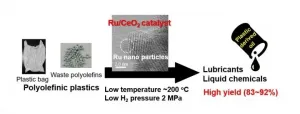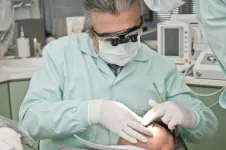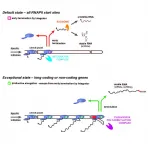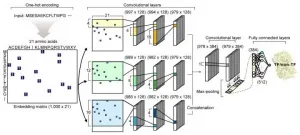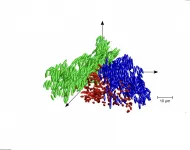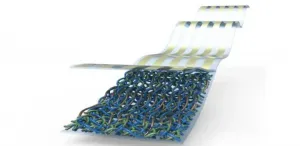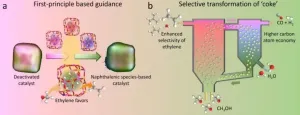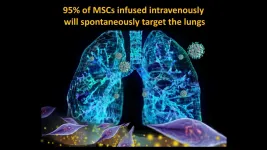Making therapeutic sense of antisense oligonucleotides
2021-01-05
(Press-News.org) Researchers from Tokyo Medical and Dental University (TMDU) and Ionis Pharmaceuticals, USA, report a modification wherein replacing the RNA strand of a heteroduplex oligonucleotide with DNA may enhance the efficacy of antisense oligonucleotide-based drugs
Tokyo, Japan - Antisense oligonucleotides (ASO) hold great promise for pharmacotherapy. Now, researchers at Tokyo Medical and Dental University (TMDU) and Ionis Pharmaceuticals, advancing their earlier work on a heteroduplex oligonucleotide (HDO) model, have demonstrated augmentation of ASO-based drugs by replacing the RNA strand with DNA.
Many drugs work by modifying specific disease-related proteins. Unfortunately, they may also affect non-targeted proteins causing side-effects that downgrade their safety and clinical applicability. Nucleic-acid therapeutics employs an emerging class of drugs including ASOs that target disease at the genetic level by suppressing the expression of pathogenic proteins. By modifying targets hitherto undruggable by conventional pharmacotherapy, they offer potential for treating intractable diseases such as spinal muscular atrophy and Huntington disease, with several candidates in clinical use and more on the horizon.
ASOs are synthetic single-stranded molecules comprising a few dozen base pairs capable of regulating gene expression through binding to the "sense" strand of mRNA targets. Arranging nucleotides, the building blocks of genetic code, in an "antisense" or opposing order can suppress a specific RNA sequence and prevent production of harmful proteins.
The research team had earlier developed an HDO wherein the single-stranded ASO was hybridized to complementary RNA and conjugated with tocopherol. Toc-HDO(coRNA) proved more stable in serum, efficiently deliverable to target cells and more potent than the parent ASO. First author Yutaro Asami explains the rationale of the current study: "Since cellular uptake was mostly in the intact form and the parent ASO was released intracellularly, we proposed replacing the phosphodiester (PO) RNA of the complementary strand with PO DNA that is more stable and easier to manufacture."
The researchers bioengineered a DNA/DNA double-stranded oligonucelotide: Toc-HDO(coDNA). The relatively low DNAse in serum would promote stability and the molecule would be activated intracellularly by DNase degradation. The efficacy of this molecular modification was evaluated using murine hepatocyte uptake assay, quantitative real-time PCR assay for RNA levels and fluorescence-based determination of hepatic ASO concentrations. "We could establish the efficacy of Toc-HDO(coDNA) on mRNA expression levels in comparison with parent ASOs of varied compositions," claims Asami. "Moreover, we also elucidated coDNA strand structure-activity relationships and degradation kinetics in mouse liver cells."
Senior author Professor Takanori Yokota looks into the future. "HDO technology promises personalized targeted therapy for several neurodegenerative and other intractable diseases. Our innovative molecular structural modifications, by enhancing clinical potency and safety, help enlarge the therapeutic toolkit on this versatile platform."
INFORMATION:
The article, "Efficient Gene Suppression by DNA/DNA Double-Stranded Oligonucleotide In Vivo" was published in Molecular Therapy at DOI: 10.1016/j.ymthe.2020.10.017
[Attachments] See images for this press release:
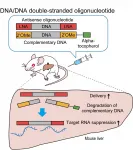
ELSE PRESS RELEASES FROM THIS DATE:
2021-01-05
For the first time, researchers have used a novel catalyst process to recycle a type of plastic found in everything from grocery bags and food packaging to toys and electronics into liquid fuels and wax.
The team published their results on Dec. 10 in Applied Catalysis B: Environmental.
"Plastics are essential materials for our life because they bring safety and hygiene to our society," said paper co-authors Masazumi Tamura, associate professor in the Research Center for Artificial Photosynthesis in the Advanced Research Institute for Natural Science and Technology in Osaka City University, and Keiichi Tomishige, professor in the Graduate School of Engineering in Tohoku University. "However, the growth of the global ...
2021-01-05
An imbalance of the body's oxygen producing free radicals and its antioxidant cells could be the reason why gum disease and chronic kidney disease affect each other, a new study led by the University of Birmingham has found.
Periodontitis - or gum disease - is a common, inflammatory disease which causes bleeding gums, wobbly or drifting teeth and can eventually result in tooth loss.
Previous studies have shown a link between the severe oral inflammation caused by gum disease and chronic kidney disease (CKD) which demonstrated that those with worse inflammation of the gums have worse kidney function.
Previous research also showed that patients with CKD and periodontitis experience ...
2021-01-05
Practicing gratitude and looking to the future will help safeguard our mental wellbeing during Covid-19 lockdowns, a new study in the Journal of Positive Psychology reports.
In the first study of its kind, researchers from the University of Surrey investigated the effectiveness of three psychological interventions -- nostalgia, a sentimentality for the past; gratitude, recognising the good things currently in our life; and best possible self, thinking about positive elements of the future -- and how they each affect wellbeing during lockdowns.
Personal characteristics such as emotion regulation (the ability to respond ...
2021-01-05
In a joint collaboration, Danish and German researchers have characterized a cellular activity that protects our cells from potentially toxic by-products of gene expression. This activity is central for the ability of multicellular organisms to uphold a robust evolutionary 'reservoir' of gene products.
Manufacturing processes need quality control systems in order to ensure proper assembly of functional products. Moreover, space-consuming, and perhaps even toxic, by-products of such processes need to be properly discarded or recycled by efficient waste handling systems.
By analogy, transcription of our genome is an imperfect process that produces large quantities of non-functional and potentially harmful transcripts both from within and ...
2021-01-05
Researchers at the Francis Crick Institute and the University of Western Australia have developed a new imaging method to see where antibiotics have reached bacteria within tissues. The method could be used to help develop more effective antibiotic treatments, reducing the risk of antibiotic resistance.
During bacterial infections like tuberculosis, bacteria enter human cells, which poses a challenge for treatment, as antibiotics must reach and enter all infected cells in order to be effective. If researchers could select for or develop more effective antibiotics based on where they reach, this may reduce the length of treatment ...
2021-01-05
A joint research team from KAIST and UCSD has developed a deep neural network named DeepTFactor that predicts transcription factors from protein sequences. DeepTFactor will serve as a useful tool for understanding the regulatory systems of organisms, accelerating the use of deep learning for solving biological problems.
A transcription factor is a protein that specifically binds to DNA sequences to control the transcription initiation. Analyzing transcriptional regulation enables the understanding of how organisms control gene expression in response to genetic or environmental changes. In this regard, finding the transcription factor of an organism is the first step in the analysis ...
2021-01-05
While glass is a truly ubiquitous material that we use on a daily basis, it also represents a major scientific conundrum. Contrary to what one might expect, the true nature of glass remains something of a mystery, with scientific inquiry into its chemical and physical properties still underway. In chemistry and physics, the term glass itself is a mutable concept: It includes the substance we know as window glass, but it may also refer to a range of other materials with properties that can be explained by reference to glass-like behaviour, including, for instance, ...
2021-01-05
Sunlight offers a potential solution in the search for an energy source that does not harm the planet, but this depends on finding a way to efficiently turn electromagnetic energy into electricity. Researchers from KAUST have shown how a known herbicide can improve this conversion in organic devices.
While solar cells have traditionally been made from inorganic materials such as silicon, organic materials are starting to break through as an alternative because they are light, flexible and relatively inexpensive to make, even offering the possibility for ...
2021-01-05
MTO process, which was first commercialized in 2010, is a catalytic process converting methanol, which is typically made from coal, natural gas, biomass, and CO2, over SAPO-34 zeolite catalyst. It's becoming one of the main streams for producing light olefins, including ethylene and propylene, from non-oil resources.
One of the major challenges in MTO is the rapid deactivation of zeolite catalyst due to the coke deposition.
In industrial practices, a fluidized bed reactor-regenerator configuration is normally used in order to maintain the continuous operation, in ...
2021-01-05
Dr. Camilo Ricordi, director of the Diabetes Research Institute (DRI) and Cell Transplant Center at the University of Miami Miller School of Medicine, and his team of international collaborators are reporting the results of a groundbreaking randomized controlled trial showing umbilical cord-derived mesenchymal stem cell (UC-MSC) infusions safely reduce risk of death and quicken time to recovery for the most severe COVID-19 patients. Dr. Ricordi's peer-reviewed paper has just been published in STEM CELLS Translational Medicine (SCTM) January 2021.
The clinical trial, authorized by the FDA last ...
LAST 30 PRESS RELEASES:
[Press-News.org] Making therapeutic sense of antisense oligonucleotides

